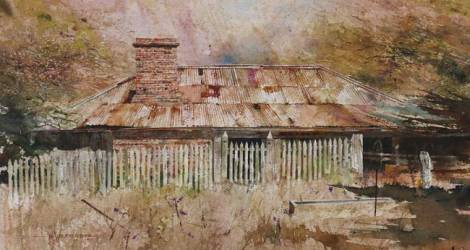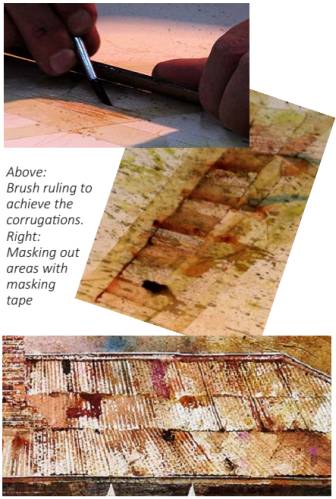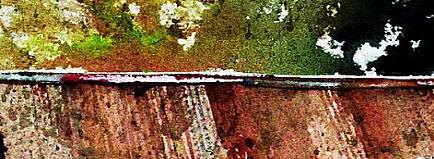Malcolm Webster Demonstration 18th October 2014
Watercolour Tips & Techniques
‘How to paint a corrugated iron roof ’ and other secrets!
 Malcolm’s advertised demonstration of a seascape had to be abandoned at
the last minute due to a sudden failure of our projection equipment.
Unfazed, Malcolm then decided to give us the benefit of his many years as
a successful, prize-winning water-colourist by passing on his tips and
techniques.
Malcolm’s advertised demonstration of a seascape had to be abandoned at
the last minute due to a sudden failure of our projection equipment.
Unfazed, Malcolm then decided to give us the benefit of his many years as
a successful, prize-winning water-colourist by passing on his tips and
techniques.
As an ice-breaker he taught us something about green. The most common
mistake is the misuse of green. When we stock up on paints in an art shop,
we usually go for a range of well-known colours. Malcolm’s advice – don’t
stock up on green. In nature there are a range of greens. He brought
samples to show us – parsley, young elm leaves, grass, gum leaves. Using
the gum leaves, he got
out some proprietary greens and painted the back of some gum leaves. We
could immediately see
how they were totally wrong.
He then showed us how mixing any blue with any vaguely yellow paint will
make green – even burnt
sienna. You should experiment with many combinations. These will give a
greater subtlety of greens. Once you have painted them you have to
“kill” them – paint over the top with a glaze of red
or sienna. Then you can use a toothpick to touch odd bits of proprietary
greens in later to infuse a
sense of green.
Malcolm showed us his 10 step method. He had a sheet of paper which he had
divided into 10.
Firstly he had given the whole page a light wash. Then he masked the first
segment with newspaper
and gave another light wash. For each segment he varied it by: adding
another colour; or different
brushing; or splashing on watercolour with a sprig of diosma bush.
Sometimes he uses diosma to
apply splashes of masking fluid that will later reveal light falling on
leaves or gravel.
The demonstration was how to paint a corrugated iron roof using this ten step method.
 Firstly he sketched the shape of the roof and drew in the joins. He used
masking tape to outline the
shape. For the roof line, cut down the middle of the tape with a slight
“wobble”. Old rooves do not
have a straight roof line! Then he washed over the whole roof with a very
light wash of Alizarin Crimson to kill off the white of the paper. He uses
a hair dryer to dry off between each stage because then you can
complete a whole painting in a day.
Firstly he sketched the shape of the roof and drew in the joins. He used
masking tape to outline the
shape. For the roof line, cut down the middle of the tape with a slight
“wobble”. Old rooves do not
have a straight roof line! Then he washed over the whole roof with a very
light wash of Alizarin Crimson to kill off the white of the paper. He uses
a hair dryer to dry off between each stage because then you can
complete a whole painting in a day.
Next he added another colour roughly, added a bit of brown. He was not worried about some colour blowing into the background when he used the dryer. For the next step he dipped a bit of diosma into paint, shook off the excess and then used it to splash colour onto the roof. Next he created some big stains of colour with a hogs hair brush and used the end of the brush to remove obvious signs of flicking.
He then dealt with the corrugated iron in two parts, masking off the bottom half with a rough edge. Perspective is important. Work out the vanishing point, then use a ruler to lightly draw some lines on the roof. Using a no. 7 sable leaning against a ruler he creates the corrugations. When ruling the lines, if you work fast it creates a broken line. Alternatively you can rule with clear water, then brush across at a diagonal with colour, just glancing over. As you work turn the ruler slightly for the perspective. He uses a range of colours for the rusty roof - even some violet. While it’s damp you can glaze over with other colours.
Along the roof line he uses rusty colours, then
some dark lines between the iron sheets. For
these he uses the same no. 7 sable, but presses it
to create a thin blade shape. When he rules the
line for the capping he twiddles the brush to get fine to thick lines.
 Finally he masks the top of the roof to do some
trees in the background. He mixes greens and
applies with the side of the brush. He mixes the
colour on the paper not on the palette. In the
background he applies just a few lines to make it
look like a forest. It doesn’t have to be detailed
because the focus is the barn not the background.
Finally he masks the top of the roof to do some
trees in the background. He mixes greens and
applies with the side of the brush. He mixes the
colour on the paper not on the palette. In the
background he applies just a few lines to make it
look like a forest. It doesn’t have to be detailed
because the focus is the barn not the background.
Malcolm favours Holbein paints because they mix
beautifully with each other. He has only a small
selection of brushes: No. 7 Sable pointed (test the
point in the shop before you buy), 1” taklon, a 3”
Hake, a ¾”hogs hair for flicking and a toothbrush
for removing unwanted colour. He also keeps his
old worn hake because it can be used for creating special effects. Well
done Malcolm.